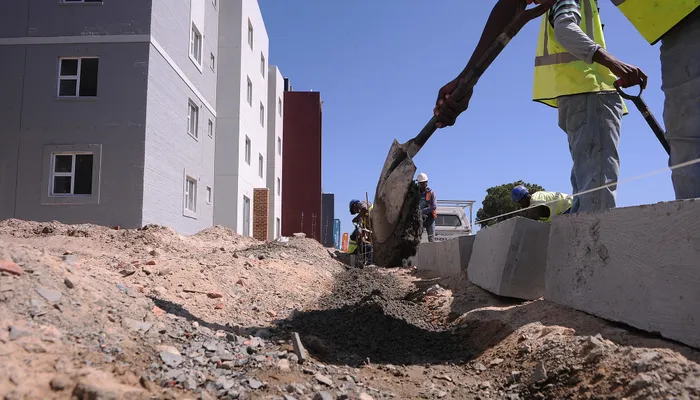SA economy at risk of slipping into technical recession

GDP fell more than expected by 0.2% in the three months to September, after two consecutive quarters of growth, following a downwardly revised 0.5% growth in the second quarter. Picture Courtney Africa, Independent Newspapers.
SOUTH Africa’s economy is at the risk of slipping into a technical recession in the last three months of this year if the energy and logistics crises are not dealt with as gross domestic product (GDP) contracted in the third quarter of 2023, dragged by agriculture, manufacturing and construction.
A technical recession is when a country faces a back-to-back decline for two consecutive quarters in the GDP output, a situation it narrowly avoided in the first quarter of this year.
This comes as GDP fell more than expected by 0.2% in the three months to September, after two consecutive quarters of growth, following a downwardly revised 0.5% growth in the second quarter.
Statistics South Africa (Stats SA) mainly attributed the decline to persistent rotational load shedding, logistical constraints, as well as the challenging global environment.
The country is currently plagued by up to 12 hours of power cuts a day, making productivity difficult due to breakdowns of Eskom’s coal-fired energy generation fleet.
Logistical bottlenecks are also hampering the importation of goods as thousands of shipping containers are stuck on vessels outside ports due to inadequate equipment, while commodity exports are forced on road freight as a result of a collapsed railway network.
Stats SA said the contributions to the performance of the economy were evenly spread between the industries on the production side of the economy.
Statistician-general Risenga Maluleke said that on the supply side of the economy, five of the 10 industries recorded weaker results, with agriculture, manufacturing and construction the biggest drags on growth.
“The agriculture industry declined by 9.6%, driven lower mainly by field crops, animal products and horticulture products. The industry encountered several headwinds in the third quarter, including the outbreak of avian flu and the floods in the Western Cape,” Maluleke said.
“Weaker demand saw manufacturing production decline by 1.3%. The food and beverages and petroleum and chemical divisions were the biggest drags on manufacturing growth in the third quarter. The outbreak of avian flu had a negative impact too, affecting the production of chicken-related products.
“The construction industry weakened further, recording a second consecutive quarter of decline. Decreased activities were reported for residential buildings, non-residential buildings and construction works.”
Mining production also declined by 1.1%, with downward pressure from platinum group metals, gold, “other” metallic minerals and manganese ore.
Weaker activity from agriculture and manufacturing also had a knock-on effect on wholesale trade, catering and accommodation industry, with the motor trade and restaurants, catering and fast food also weaker in the quarter.
On the expenditure side, Stats SA said fixed investment contracted by 3.4% and household consumption decreased by 0.3%, while government spending rose by 0.3%.
North-West University Business School economist Professor Raymond Parsons said negative factors had clearly dominated the positive ones to a greater extent than anticipated in the third quarter.
Parsons said similar economic trends were likely to also prevail in shaping a likely weak GDP growth outcome in the current fourth quarter of 2023, especially since fixed capital formation also declined.
“The year is likely to end with muted economic activity. South Africa must now avert the possibility of a ‘technical recession’ developing against the poor economic background of the third quarter of 2023,” Parsons said.
“Apart from other global and domestic headwinds, growth expectations in South Africa remain heavily dependent in particular on load shedding being steadily phased out and a higher level of energy security being achieved than presently seems to be the case.
“Furthermore, there are now also bottlenecks in Transnet’s rail and port services that are imposing widespread disruption and heavy additional costs on the economy.”
In the year-to-date, the economy expanded by 0.3% in the nine months to September.
On a year-on-year basis, Stats SA said the GDP fell by 0.7% in the third quarter following a downwardly revised 1.5% rise in the previous quarter, as favourable statistical base effects dissipated.
This has cast doubt on the South African Reserve Bank’s and National Treasury’s growth forecast of 0.8% for 2023.
FNB senior economist Thanda Sithole pointed to specific shocks during the quarter, saying the burning of trucks along key national corridors, as well as a protracted taxi strike and flooding in the Western Cape, had also disrupted economic activity.
Sithole said while load shedding persisted, they expected the intensity to have peaked this year and a gradual improvement was built into their baseline forecast of 0.8% GDP growth for 2023.
“However, today’s GDP data challenges our current-year growth forecast of 0.8%. While growth should remain below 1% this year, a gradual lift next year is envisaged – underpinned by reduced load shedding, lower inflation, and the projected interest rate relief,” Sithole said.
“Still, targeted and accelerated economic reforms are critical to lift growth and employment, ultimately helping to improve the government's fiscal position,” he said.
– BUSINESS REPORT